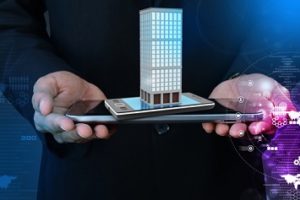Many of us have approached the one-year anniversary of “work from home, making some wonder when—and if—returning to the office is ever going to happen. With safety precautions, such as social distancing, likely to be in place through the end of the year, others are wondering what a return to work will actually look like, and how these measures will be enforced.
As everyone prepares for the eventual return to work, technology can play an important role in getting communal spaces – like offices – back open and operating safely, especially as the public waits for vaccines to become more widely available.
The Internet of Things, or IoT, provides a seamless, non-disruptive way of making sure that all guidelines are being followed, space is being appropriately used and employees and tenants are comfortable as buildings and workspaces reopen. Here’s how.
Space optimization
With work from home options likely to remain part of workplace offerings for the foreseeable future (on a part-time basis, at least), it’s unlikely that many companies will need to use the same amount of space in the same way they did before the pandemic.
The first half of the year, especially, will be filled with hybrid work options, and many managers should use this opportunity to think about how to make the most of their workspace. With the IoT, facility and office managers can take a hard look at floor plans and spaces to determine how to best utilize the space for when employees return to the office.
By placing IoT sensors around the office, managers can collect valuable information that will allow them to optimize layouts and create a more productive environment. For example, by leaving devices in a large conference room, managers might see that the space is not being use very frequently. At the same time, they might find smaller private rooms may be used far more as one or two people seek to get away from the cubicle or open space to focus.
Taking these dynamics into account, office and facility managers can get an understanding of what space is being used, and whether it’s time to up- or down-size.
Enforcing guidelines
Returning to the office isn’t just about making sure the space is optimized, but ensuring it is safe for employees to return. Luckily, IoT sensors placed on desks can allow office and building managers to ensure appropriate precautions are being followed.
By attaching an IoT device to desks and various places around the office, cleaners can be alerted when an employee leaves a desk or conference room, so they know when the space is ready to be deep cleaned in between uses. These alerts can keep cleaning efficient and timely, ensuring no time is wasted between the sanitation process and sharing desks or other equipment.
Likewise, by placing IoT devices at desks, employers can gain relevant information about which desks are occupied and which ones are vacant. With this information, employers and HR executives can monitor the number of people in the building to prove compliance with occupancy requirements to local health authorities, as well as ensure that proper social distancing measures are being followed.
Ensuring wellbeing
The IoT can also be used to monitor for other factors in buildings that impact health and safety, such as air quality. By using IoT enabled sensors, building managers can maintain proper ventilation and guarantee the best, healthiest conditions for employees.
The sensors are easy to install and inexpensive to run, leaving building managers with the ability to cover the entire building, enabling several metrics to be tracked such as humidity, air quality, temperature and more. With this data at their fingertips, building managers can monitor for any fluctuations that would make conditions unsafe, and understand the best times to ventilate spaces. As we’ve seen in the last year, air quality and proper ventilation is incredibly important to limiting the spread of the coronavirus in indoor spaces.
The return to the office will hopefully be a conversation many begin to have later this year, especially as vaccines become more available. However, it’s important to remember that even with this added layer of protection, safety measures must still be taken in shared spaces. Luckily, the IoT can help provide a safe, productive return to workspaces – giving employers and employees the peace of mind needed to pick up right where they left off.
| Hussain Suleman is is the VP of Sales at Sigfox USA. |

